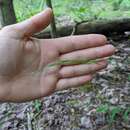Comprehensive Description
provided by North American Flora
Brachyelytrum erectum (Schreb.) Beauv. Agrost. 39, 155. 1812
? Dilepyrum aristosum Michx. Fl. Bor. Am. I: 40. 1803. (Type from Georgia and Carolina.) ? Muhlenbergia arislata Pers. Syn. PI. 1: 73. 1805. (Based on Dilepyrum aristosum Michx.) Muhlenbergia erecla Schreb. in Spreng. M6m. Acad. St.-Petersb. 2: 287. 1807-8. (Type from
Georgia and Carolina.) ? Brachyelytrum aristatum R. & S. Syst. Veg. 2: 413. 1817. (Based on Dilepyrum aristosum Michx.) Muhlenbergia Brachyelytrum Trin. Gram. Unifl. 188. 1824. (Based on Brachyelytrum erectum
Beauv.) Agrostis erecla Spreng. Syst. 1: 264. 1825. (Based on Muhlenbergia erecta Schreb.) Brachyelytrum aristatum var. Engelmanni A. Gray, Man. ed. 5. 614. 1867. ("A western form.") ? Brachyelytrum aristosum Trel. Brann. & Coville, in Brann. & Cov. Rep. Geol. Surv. Ark. 1888<: 235.
1891. (Based on Dilepyrum aristosum Michx.) Brachyelytrum aristosum var. glabralum Vasey. in Millsp. Bull. W. Va. Exp. Sta. 24: 469. 1892. Dilepyrum erectum Farwell, Am. Mid!. Nat. 8: 33. 1922. (Based on Muhlenbergia erecla Schreb.)
Culms usually few in a tuft, erect, glabrous to rather densely retrorse-pilose, 50-100 cm. tall; sheaths more or less retrorsely pilose; ligule truncate, 1-2 mm. long; blades flat, thin, scabrous and sometimes sparsely pilose on the upper surface, usually more or less pilose beneath especially on the veins, acuminate, narrowed at the base, 7-15 cm. long, 1-1.5 cm. wide; panicle narrow, 5-15 cm. long, the short branches appressed, few-flowered; first glume small or obsolete; second glume 0.5-2 mm. long; lemma readily deciduous, subterete, about 1 cm. long, scabrous, the nerves sometimes hispid, the awn 1-3 cm. long.
Type locality: Georgia and Carolina.
Distribution: Moist or rocky woods. Newfoundland to Minnesota, and southward to Georgia and Oklahoma.
- bibliographic citation
- Albert Spear Hitchcock. 1935. (POALES); POACEAE (pars). North American flora. vol 17(6). New York Botanical Garden, New York, NY
Physical Description
provided by USDA PLANTS text
Perennials, Terrestrial, not aquatic, Rhizomes present, Rhizome short and compact, stems close, Stems nodes swollen or brittle, Stems erect or ascending, Stems terete, round in cross section, or polygonal, Stem nodes bearded or hairy, Stem internodes solid or spongy, Stem internodes hollow, Stems with inflorescence less than 1 m tall, Stems, culms, or scapes exceeding basal leaves, Leaves mostly cauline, Leaves conspicuously 2-ranked, distichous, Leaf tips flexuous, drooping, blades thin, lax, soft, Leaves sheathing at base, Leaf sheath mostly open, or loose, Leaf sheath hairy, hispid or prickly, Leaf sheath and blade differentiated, Leaf blades linear, Leaf blades lanceolate, Leaf blades 2-10 mm wide, Leaf blades 1-2 cm wide, Leaf blades mostly flat, Leaf blade with prominently raised or widened midvein, Leaf blades more or less hairy, Leaf blades scabrous, roughened, or wrinkled, Ligule present, Ligule an unfringed eciliate membrane, Ligule a fringed, ciliate, or lobed membrane, Inflorescence terminal, Inflorescence a contracted panicle, narrowly paniculate, branches appressed or ascending, Inflorescence solitary, with 1 spike, fascicle, glomerule, head, or cluster per stem or culm, Inflorescence a panicle with narrowly racemose or spicate branches, Inflorescence with 2-10 branches, Flowers bisexual, Spikelets sessile or subsessile, Spikelets dorsally compressed or terete, Spikelet less than 3 mm wide, Spikelets with 1 fertile floret, Spikelets solitary at rachis nodes, Spikelets all alike and fertille, Spikelets bisexual, Spikelets disarticulating above the glum es, glumes persistent, Spikelets disarticulating beneath or between the florets, Rachilla or pedicel glabrous, Glumes present, empty bracts, Glumes 2 clearly present, Glumes distinctly unequal, Glumes shorter than adjacent lemma, Glumes 1 nerved, Lemma similar in texture to glumes, Lemma 5-7 nerved, Lemma body or surface hairy, Lemma rugose, with cross wrinkles, or roughened, Lemma apex acute or acuminate, Lemma distinctly awned, more than 2-3 mm, Lemma with 1 awn, Lemma awn less than 1 cm long, Lemma awn 1-2 cm long, Lemma awned from tip, Lemma awns straight or curved to base, Lemma margins thin, lying flat, Lemma straight, Palea present, well developed, Palea membranous, hyaline, Palea about equal to lemma, Palea 2 nerved or 2 keeled, Stamens 3, Styles 2-fid, deeply 2-branched, Stigmas 2, Fruit - caryopsis, Caryopsis ellipsoid, longitudinally grooved, hilum long-linear.
Brachyelytrum erectum: Brief Summary
provided by wikipedia EN
Brachyelytrum erectum, known as the southern shorthusk or the southern long-awned woodgrass, is a perennial grass native to North America. Its specific epithet "erectum" refers to the erect culms of the grass. Its diploid number is 22.
- license
- cc-by-sa-3.0
- copyright
- Wikipedia authors and editors

